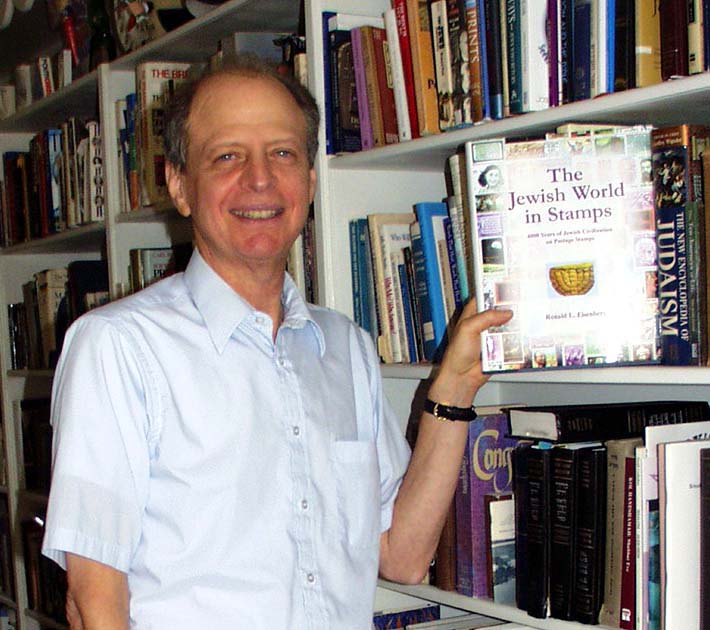|
By Donald H. Harrison
SAN DIEGO—Radiologist Ronald Eisenberg was visiting Hadassah Hospital in
Jerusalem on business when he noticed that some of the people who were honored
on Jerusalem's street signs were utterly unknown to him.
Eisenberg not only has written some of the standard textbooks of radiology, the
Oakland, Calif.-based doctor also has written three highly readable reference
books on Jewish subjects in the last four years, so learning about the
people for whom the streets were named was more than a passing fancy. It
was the road to another book.
In San Diego with his wife, the violinist Zina
Schiff, to celebrate the Passover holidays with members of her family,
Eisenberg related the course of his research during an interview with jewishsightseeing.com.
 He
said that he tried to learn enough information about each of the 1,800 streets
in Jerusalem sufficient to satisfy the curiosity of a visitor to that
city. He
said that he tried to learn enough information about each of the 1,800 streets
in Jerusalem sufficient to satisfy the curiosity of a visitor to that
city.
Such a high number of research avenues might have been daunting to another
author, but it was right up Eisenberg's alley. His book, The Jewish
World in Stamps, published in 2002, dealt with more than 2,000 postage
stamps illustrating Jewish themes. His JPS Guide to Jewish
Traditions, issued in 2004, provided hundreds of facts on Jewish life cycle
events, Jewish holidays, synagogue rituals and prayers. And his most
recent book, The 613 Mitzvot, issued last year, enumerated and explained
each of the commandments that Jews are expected to follow.
To research this book, The Streets of Jerusalem: Who,
What, Why, which Devora Publishing plans to place this fall in Jerusalem
bookstores, Eisenberg began by calling employees of the City of Jerusalem, only
to find that workers in the various branches of the municipality said they had
no information on the origins of the city's street names.
He next went to Carta, the publisher of Jerusalem's
best-known map, which knew where all the streets were, but was unable to provide
any history of their nomenclature. Eisenberg did locate two books
written in Hebrew some 30 years ago that discussed some of the street
names—but in some cases the streets subsequently had been renamed. From
these books, encyclopedias, history books, his own previous research on postage
stamps, and, of course, the Internet, Eisenberg was able to track down
background on the names of 1,400 of the 1,800 streets.
Some of the themes used in naming Jerusalem's streets were easy to discern,
Eisenberg said. For example the sons of the biblical Jacob all have
Jerusalem streets named for them. So too do Talmudic rabbis, medieval
rabbis, and founders of Chasidic dynasties.
There are streets named for leaders in the various waves of immigration to
Israel and for famous Zionists. So too are there streets named after
famous opponents or resisters of the Nazi Holocaust, and for political figures
involved in the establishment of the State of Israel like David Ben-Gurion,
Chaim Weizmann and Ze'ev Jabotinsy. Similar honors are accorded later
Israeli prime ministers such as Golda Meir, Levi Eshkol, Menachem Begin and
Yitzhak Rabin.
Incidentally, Eisenberg reported with a smile, in the Jerusalem area when a sign
identifies the "Begin" freeway, it really is honoring the
former Israeli Prime Minister and is not, like so many signs in the United
States, merely identifying the starting point of a heavily traveled roadway.
Streets also were named in Jerusalem for foreign statesmen whom the
Israelis admired, including such U.S. Presidents as George Washington, Abraham
Lincoln and Harry Truman; British Prime Minister Winston Churchill and South
African leader Jan Smuts.
However, not all the names could be so easily identified. Eisenberg believes
that some of the 400 streets about which he could find no
information may have been named after local figures—people who might
have been involved in the development of specific neighborhoods or even
institutions within those neighborhoods.
The author said that compiling the book provided an interesting journey into
Israeli history. For example, he said he had never seen the movie Cast
A Giant Shadow starring Kirk Douglas, so he had been unfamiliar with Mickey
Marcus—the American who helped train and organize the Israeli Army and
ironically was killed by "friendly fire" because he did not know how
to give a password in Hebrew. The way Marcus died, in Eisenberg's view, is a
compelling argument for the necessity of learning the language of any
place where you plan to spend any length of time.
Of course, not all of Jerusalem's streets are named for
people. Some take the names of famous dates in Israeli history, others
celebrate events in Jewish and world history, and still others describe their
surroundings, such as "panoramic view." There also are quite a few
streets named after plants and flowers, Eisenberg said.
Eisenberg said The Streets of Jerusalem will be illustrated both with
pictures of some of the streets' namesakes as well as with scenes from the
streets themselves.
With the book now safely in the hands of the publisher, Eisenberg is collecting
data for another project—one which, according to his custom, he declines to
describe until after it is written. But he did divulge that the subject
matter is biblical, adding the teaser that while Modern Orthodox rabbis will
have no objection to his subject matter, it could possibly be controversial in
the Haredi community.
The doctor smiled and declined to say more. Too bad that there is nothing
written in any of his radiology textbooks about how we might x-ray him to find
out what's in his mind.
|

